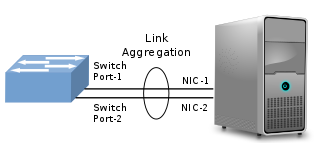Routing is the process of selecting a path for traffic in a network or between or across multiple networks. Broadly, routing is performed in many types of networks, including circuit-switched networks, such as the public switched telephone network (PSTN), and computer networks, such as the Internet.
Network throughput refers to the rate of message delivery over a communication channel in a communication network, such as Ethernet or packet radio. The data that these messages contain may be delivered over physical or logical links, or through network nodes. Throughput is usually measured in bits per second, and sometimes in packets per second or data packets per time slot.

Wake-on-LAN is an Ethernet or Token Ring computer networking standard that allows a computer to be turned on or awakened from sleep mode by a network message. It is based upon AMD's Magic Packet Technology, which was co-developed by AMD and Hewlett-Packard, following its proposal as a standard in 1995. The standard saw quick adoption thereafter through IBM, Intel and others.

Border Gateway Protocol (BGP) is a standardized exterior gateway protocol designed to exchange routing and reachability information among autonomous systems (AS) on the Internet. BGP is classified as a path-vector routing protocol, and it makes routing decisions based on paths, network policies, or rule-sets configured by a network administrator.
Open Shortest Path First (OSPF) is a routing protocol for Internet Protocol (IP) networks. It uses a link state routing (LSR) algorithm and falls into the group of interior gateway protocols (IGPs), operating within a single autonomous system (AS).
The data link layer, or layer 2, is the second layer of the seven-layer OSI model of computer networking. This layer is the protocol layer that transfers data between nodes on a network segment across the physical layer. The data link layer provides the functional and procedural means to transfer data between network entities and may also provide the means to detect and possibly correct errors that can occur in the physical layer.
Loopback is the routing of electronic signals or digital data streams back to their source without intentional processing or modification. It is primarily a means of testing the communications infrastructure.

A controller area network (CAN) is a vehicle bus standard designed to enable efficient communication primarily between electronic control units (ECUs). Originally developed to reduce the complexity and cost of electrical wiring in automobiles through multiplexing, the CAN bus protocol has since been adopted in various other contexts. This broadcast-based, message-oriented protocol ensures data integrity and prioritization through a process called arbitration, allowing the highest priority device to continue transmitting if multiple devices attempt to send data simultaneously, while others back off. Its reliability is enhanced by differential signaling, which mitigates electrical noise. Common versions of the CAN protocol include CAN 2.0, CAN FD, and CAN XL which vary in their data rate capabilities and maximum data payload sizes.
Bus contention is an undesirable state in computer design where more than one device on a bus attempts to place values on it at the same time.
errno.h is a header file in the standard library of the C programming language. It defines macros for reporting and retrieving error conditions using the symbol errno.
Network congestion in data networking and queueing theory is the reduced quality of service that occurs when a network node or link is carrying more data than it can handle. Typical effects include queueing delay, packet loss or the blocking of new connections. A consequence of congestion is that an incremental increase in offered load leads either only to a small increase or even a decrease in network throughput.

A supernetwork, or supernet, is an Internet Protocol (IP) network that is formed by aggregation of multiple networks into a larger network. The new routing prefix for the aggregate network represents the constituent networks in a single routing table entry. The process of forming a supernet is called supernetting, prefix aggregation, route aggregation, or route summarization.

The RapidIO architecture is a high-performance packet-switched electrical connection technology. It supports messaging, read/write and cache coherency semantics. Based on industry-standard electrical specifications such as those for Ethernet, RapidIO can be used as a chip-to-chip, board-to-board, and chassis-to-chassis interconnect.
A network tap is a system that monitors events on a local network. A tap is typically a dedicated hardware device, which provides a way to access the data flowing across a computer network.

In computer networking, link aggregation is the combining of multiple network connections in parallel by any of several methods. Link aggregation increases total throughput beyond what a single connection could sustain, and provides redundancy where all but one of the physical links may fail without losing connectivity. A link aggregation group (LAG) is the combined collection of physical ports.

In engineering and systems theory, redundancy is the intentional duplication of critical components or functions of a system with the goal of increasing reliability of the system, usually in the form of a backup or fail-safe, or to improve actual system performance, such as in the case of GNSS receivers, or multi-threaded computer processing.
The Hazy-Sighted Link State Routing Protocol (HSLS) is a wireless mesh network routing protocol being developed by the CUWiN Foundation. This is an algorithm allowing computers communicating via digital radio in a mesh network to forward messages to computers that are out of reach of direct radio contact. Its network overhead is theoretically optimal, utilizing both proactive and reactive link-state routing to limit network updates in space and time. Its inventors believe it is a more efficient protocol to route wired networks as well. HSLS was invented by researchers at BBN Technologies.
Packet loss occurs when one or more packets of data travelling across a computer network fail to reach their destination. Packet loss is either caused by errors in data transmission, typically across wireless networks, or network congestion. Packet loss is measured as a percentage of packets lost with respect to packets sent.
Convergence is the state of a set of routers that have the same topological information about the internetwork in which they operate. For a set of routers to have converged, they must have collected all available topology information from each other via the implemented routing protocol, the information they gathered must not contradict any other router's topology information in the set, and it must reflect the real state of the network. In other words: in a converged network all routers "agree" on what the network topology looks like.
A communication protocol is a system of rules that allows two or more entities of a communications system to transmit information via any variation of a physical quantity. The protocol defines the rules, syntax, semantics, and synchronization of communication and possible error recovery methods. Protocols may be implemented by hardware, software, or a combination of both.






